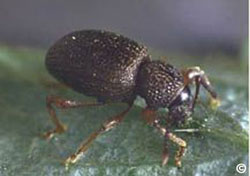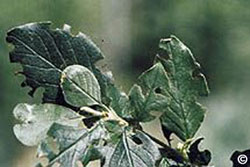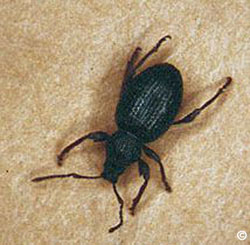What are root weevils?
Root weevils are a nuisance because they wander into homes in hot, dry summer weather and because they damage woody plants. Strawberry root  weevil,rough strawberry root weevil and black vine weevil are the three species found in the state. Euonymus, lilac and peony are the plants most commonly damaged. Insects are rarely seen because feeding occurs at night. Rectangular notches of leaf edges differentiate root weevil damage from that of leaf cutter bees (half-moon shaped cuts) or grasshoppers (irregular chewing).
weevil,rough strawberry root weevil and black vine weevil are the three species found in the state. Euonymus, lilac and peony are the plants most commonly damaged. Insects are rarely seen because feeding occurs at night. Rectangular notches of leaf edges differentiate root weevil damage from that of leaf cutter bees (half-moon shaped cuts) or grasshoppers (irregular chewing).
Are root weevils harmful during the winter?

Root weevils generally overwinter as nearly full-grown, pale legless larvae that feed on the roots of strawberry, raspberry, clover, spruce and other plants. Pupation occurs in the soil and the 1/4 to 1/2 inch long adults emerge in June. Adults hide and lay eggs near the crowns of plants.
How can I prevent root weevils?
 Apply acephate (Orthene) as a foliar application when leaf notching is first observed. This may need to be repeated at 3 week intervals from July through August. Acephate is also used to treat for root injury due to larval feeding. Foliage and soil drench treatments should be made starting in June to kill adults before egg-laying.
Apply acephate (Orthene) as a foliar application when leaf notching is first observed. This may need to be repeated at 3 week intervals from July through August. Acephate is also used to treat for root injury due to larval feeding. Foliage and soil drench treatments should be made starting in June to kill adults before egg-laying.
For more information, see the following Colorado State University Extension fact sheet(s).



